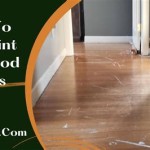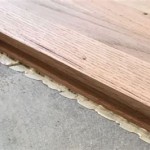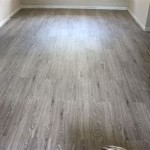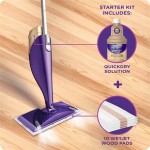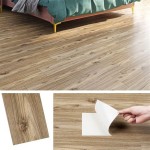Understanding and Addressing Black Stains on Wood Floors
Black stains on wood floors can be a distressing sight for homeowners. They mar the aesthetic appeal of the flooring and often indicate a more significant underlying issue. These unsightly marks are not merely surface blemishes; they are typically the result of a chemical reaction, moisture penetration, or fungal growth within the wood itself. Identifying the cause of the stain is crucial for effective treatment and prevention of future occurrences.
The color of the stain is a significant indicator of its origin. While black is the most noticeable, other colorations such as dark brown or gray can also signify similar problems. The location of the stain is also informative. Stains near doorways or windows might indicate water intrusion from external sources, while those around appliances or in bathrooms suggest plumbing leaks or spills. Addressing these issues promptly not only improves the appearance of the floor but also protects the structural integrity of the wood and prevents further damage.
Iron-Tannin Reaction: A Common Culprit
One of the most prevalent causes of black stains on wood floors is the chemical reaction between iron and tannin. Tannins are naturally occurring compounds found in many types of wood, particularly oak. When iron, typically in the form of water containing dissolved iron (ferrous ions), comes into contact with these tannins, a dark, almost black, compound is formed. This reaction is highly visible and often penetrates deep into the wood fibers, making it challenging to remove.
Sources of iron can be varied. Hard water, which is water with a high mineral content, often contains significant amounts of iron. If hard water is repeatedly spilled or splashed on the floor, or used for cleaning without proper drying, the iron can react with the tannins over time, leading to discoloration. Metal objects left in contact with the floor, such as wet metal tools or even the metal feet of furniture without protective pads, can also deposit iron and initiate the staining process. Furthermore, certain cleaning products may contain iron compounds that exacerbate the problem. The presence of iron fasteners, such as nails or screws, can also contribute to the staining, especially if moisture is present.
Identifying iron-tannin stains often involves looking for telltale signs. The stains are typically dark, almost black, and may have a somewhat metallic sheen in certain light. They often appear in areas where water is frequently spilled or where metal objects are regularly placed. In cases where nails or screws are the source, the staining will be localized around the fastener.
Treatment for iron-tannin stains usually involves the use of oxalic acid, a chemical compound known for its ability to bleach wood. The process requires careful application, as oxalic acid is corrosive and can damage the wood if used improperly. Proper safety precautions, including wearing gloves and eye protection, are essential. The affected area should be thoroughly cleaned to remove any surface dirt or debris before applying the oxalic acid solution. After application, the area should be neutralized and rinsed thoroughly to prevent further chemical reactions. In severe cases, sanding and refinishing the affected area may be necessary to completely remove the stain and restore the original appearance of the floor.
Moisture Damage and Mold Growth
Another significant contributor to black stains on wood floors is prolonged exposure to moisture, which can lead to the growth of mold and mildew. Wood is a porous material that readily absorbs moisture from the environment. When wood remains damp for extended periods, it creates an ideal environment for these fungi to thrive. Mold and mildew not only discolor the wood but also can weaken its structure and contribute to health problems.
Sources of moisture can be diverse. Leaks from plumbing fixtures, such as pipes under sinks or behind toilets, are common culprits. Spills that are not immediately cleaned up can also penetrate the wood and foster mold growth. High humidity levels, particularly in basements or bathrooms, can create a consistently damp environment that encourages fungal growth. Condensation from windows or poorly insulated walls can also introduce moisture into the wood floor. Inadequate ventilation, especially in enclosed spaces, can trap moisture and exacerbate the problem.
The appearance of mold and mildew stains can vary depending on the type of fungi involved. Black stains are common, but they can also appear as green, brown, or even white patches. The stains often have a fuzzy or powdery texture, and a musty odor may be present. In severe cases, the wood may become soft and spongy, indicating significant structural damage.
Addressing mold and mildew stains requires a multi-faceted approach. First, it is crucial to identify and eliminate the source of moisture. This may involve repairing plumbing leaks, improving ventilation, or addressing humidity issues. Once the moisture source is resolved, the affected area should be thoroughly cleaned using a solution specifically designed to kill mold and mildew. Bleach solutions can be effective, but they should be used with caution, as they can also damage the wood and discolor it further. After cleaning, the area should be thoroughly dried to prevent further fungal growth. In cases of severe mold infestation, it may be necessary to remove and replace the affected sections of the wood floor. Professional mold remediation services may be required to ensure that the mold is completely eradicated and that the air quality in the home is safe.
Pet Urine and Other Organic Stains
Pet urine is another common cause of black stains on wood floors, particularly in households with pets. Urine contains ammonia and other organic compounds that can react with the wood and cause discoloration. The staining can be exacerbated by the acidity of the urine, which can etch into the wood's surface. Moreover, pet urine often penetrates deep into the wood fibers, making it difficult to remove completely.
The appearance of pet urine stains varies depending on the type of wood, the length of time the urine has been present, and the frequency of the accidents. Fresh urine stains may appear as light yellow or brown spots, but over time, they can darken to black. The stains often have a distinct odor, even after cleaning. In severe cases, the urine can damage the wood's finish and cause the wood to warp or buckle.
Other organic stains, such as those from spilled food or drinks, can also cause discoloration on wood floors. Dark-colored liquids, such as coffee, tea, or red wine, can leave permanent stains if not cleaned up promptly. These stains may not always be black, but they can still detract from the appearance of the floor.
Treating pet urine and other organic stains requires a prompt and thorough approach. The first step is to absorb as much of the liquid as possible with a clean cloth or paper towel. Avoid rubbing the stain, as this can spread it further. Next, clean the area with a specialized pet stain remover or a mild detergent solution. Enzyme-based cleaners are particularly effective at breaking down the organic compounds in urine and eliminating odors. After cleaning, rinse the area thoroughly with clean water and dry it completely. For stubborn stains, it may be necessary to use a stronger cleaning solution or to sand and refinish the affected area. In cases of severe damage, replacing the affected section of the floor may be the only option. To prevent future stains, it is important to train pets to eliminate outdoors and to clean up any accidents immediately. Protecting the floor with rugs or mats in high-traffic areas can also help to prevent spills and stains.
In summary, identifying the source of a black stain on a wood floor is essential for effective treatment and prevention. Whether the cause is an iron-tannin reaction, moisture damage leading to mold growth, or organic stains from pet urine or spills, addressing the underlying issue is paramount. Proper cleaning techniques, the use of appropriate cleaning solutions, and preventative measures can help to maintain the beauty and integrity of wood floors for years to come.

Ultimate Guide How To Remove Black Stains From Hardwood Floors

Thinking Of Staining Your Hardwood Floors A Dark Color

Thinking Of Staining Your Hardwood Floors A Dark Color

Thinking Of Staining Your Hardwood Floors A Dark Color

Thinking Of Staining Your Hardwood Floors A Dark Color

Thinking Of Staining Your Hardwood Floors A Dark Color

How Do I Remove Dark Pet Stains On My Finished Hardwood Floor Hometalk

Black Stains Adhesive While Finishing Wood Floors Options Removal Coatings Doityourself Com Community Forums

How Can I Remove Spot Stains From This Hardwood Floor Home Improvement Stack Exchange

Thinking Of Staining Your Hardwood Floors A Dark Color

